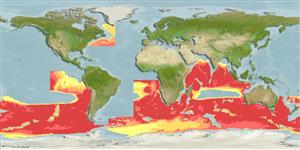Common names from other countries
Classification / Names / Names
Namen | Synonyme | Catalog of Fishes (gen., sp.) | ITIS | CoL | WoRMS
Environment: milieu / climate zone / depth range / distribution range
Ökologie
; tiefenbereich 3000 - 7000 m (Ref. 2665). Polar
Atlantic Ocean, Indo-Pacific, Antarctic, and the Mediterranean: Subantarctic Region, Western South America, and Europe.
Length at first maturity / Size / Gewicht / Alter
Maturity: Lm ? range ? - ? cm Max length : 2.0 cm TL Männchen/unbestimmt; (Ref. 3462)
Minimum depth from Ref. 2892. Attached to small stones (Ref. 1744). Generally fixed on rocky bottom, loose blocks, polymetallic nodules and plates, and shells (Ref. 2665).
Life cycle and mating behavior
Geschlechtsreife | Fortpflanzung | Ablaichen | Eier | Fecundity | Larven
Members of the class Ascidiacea are hermaphroditic; both cross- and self-fertilization is typical. Life cycle: Eggs develop into lecithotrophic larva before metamorphosing into benthic adults.
Sanamyan, K.E. and N.P. Sanamyan. 2002. (Ref. 1744)
IUCN Rote Liste Status (Ref. 130435)
CITES Status (Ref. 108899)
Not Evaluated
Not Evaluated
Nutzung durch Menschen
| FishSource |
Tools
Mehr Information
Alter/Größe
Wachstum
Länge-Gewicht
Länge-Länge
Morphologie
Larven
Dichte
Internet Quellen
Estimates based on models
Preferred temperature
(Ref.
115969): 0 - 1.9, mean 1.2 (based on 18442 cells).
Verwundbarkeit
Low vulnerability (10 of 100).
Preiskategorie
Unknown.
